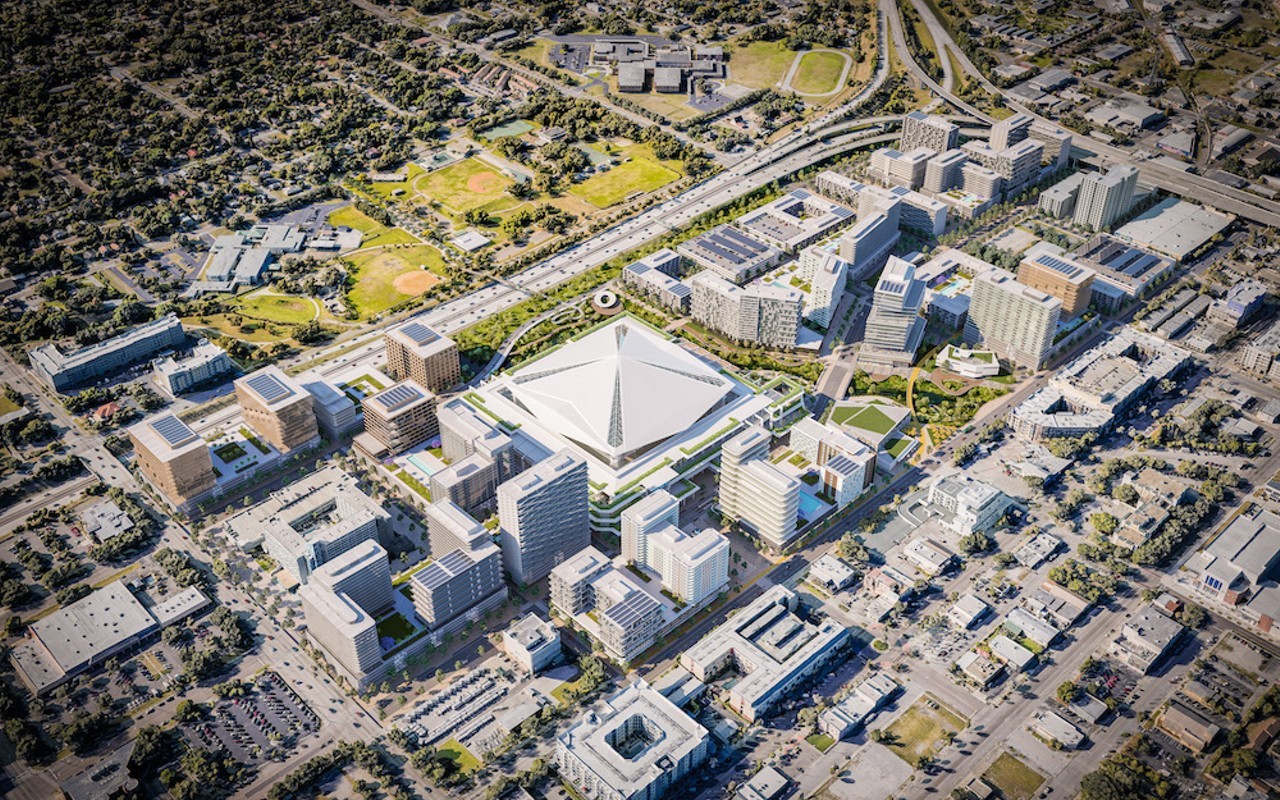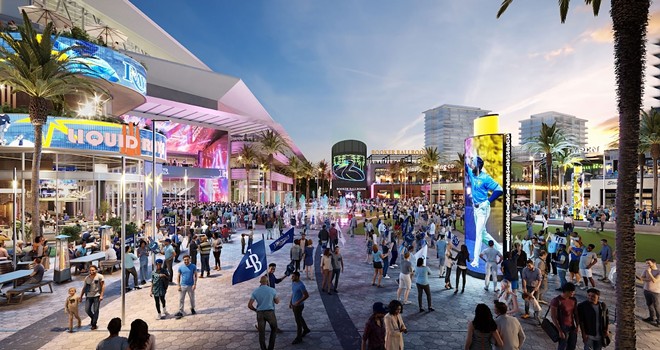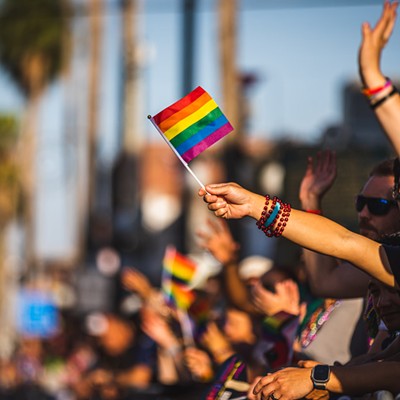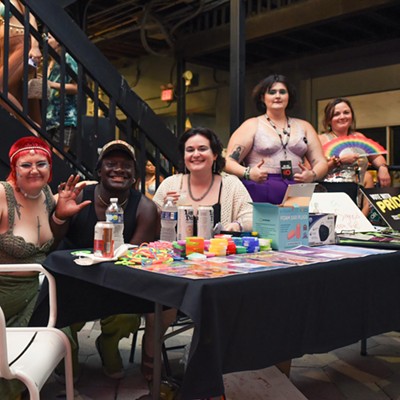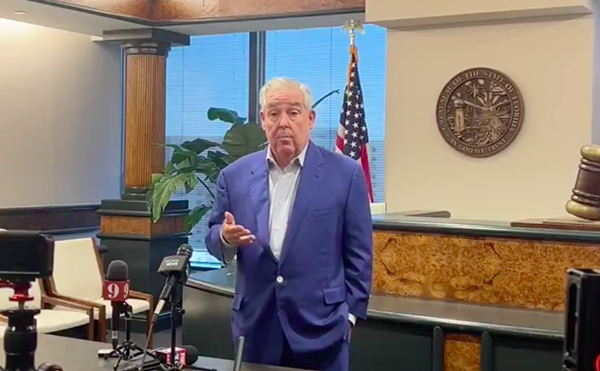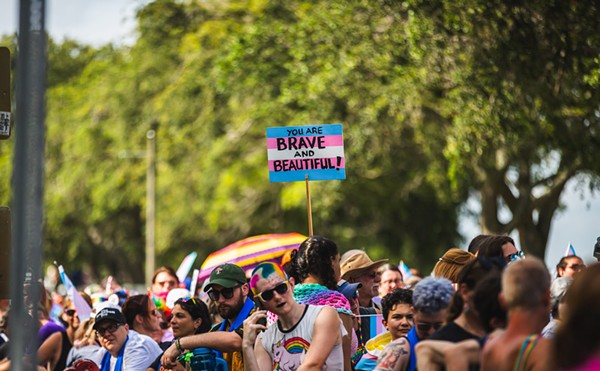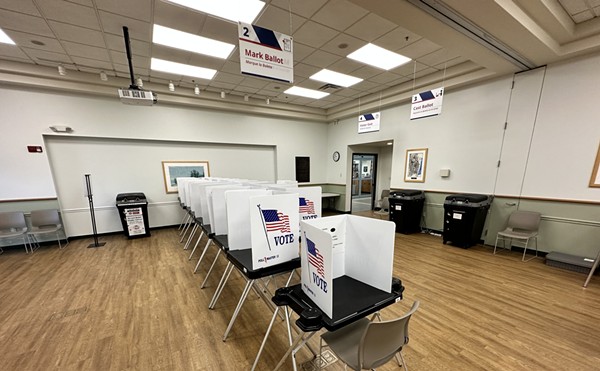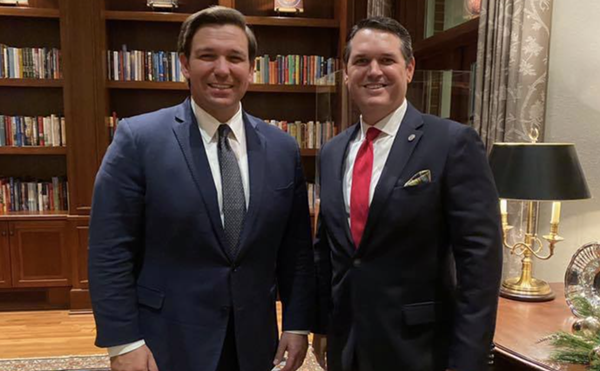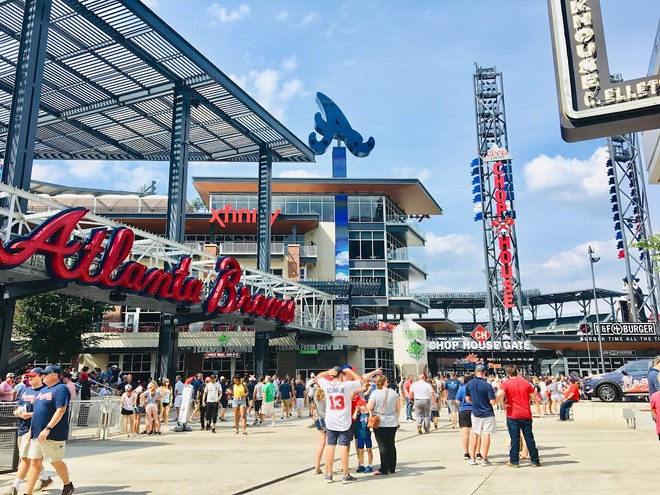
"Unreal city, city full of dreams,Traffic had stopped dead 12 miles south of the beltway.
Where ghosts in broad daylight cling to passers-by.”—T.S. Eliot
My wife Julie and I were driving north to The Battery, the glitzy entertainment district next to Truist Park, the Braves' new stadium in Cobb County, just outside Atlanta. Truist Park is a Populous product, the same company the Tampa Bay Rays have strong-armed St. Petersburg into using for the Trop site. Every corner of Tampa Bay's stadium debate has been covered by this point. Every aspect, that is, except the outcome: is this what we even want? Does the end serve what the city most needs? Julie and I drove the seven hours up I-75 to see an equivalent.
Mostly, we saw traffic.
We passed historic Turner Field, site of the 1996 Olympics, and home of the Braves until 2017. The map on my dashboard said 15 miles, or 45 minutes. Anyone who knows Atlanta knows the reasons for this crawling pace. And why the Braves hightailed out.
When metro Atlanta planned regional transit in 1971, white folks in two outlying counties (many who had fled the integrating city) voted 4-1 against. The same suburban population, a demographic that happens to like baseball, then grew weary of their sports-commute. So Cobb County officials handed over a $722 million dollar stadium. The relocation was "about moving cars in and around Cobb," former county Republican Party chair Joe Dendy conceded, "not moving people into Cobb by rail from Atlanta." (Off record, the language gets worse.)
The deal was both textbook squandering of municipal funds and a slap in the face to Black Atlanta. Since 1970, nationwide, taxpayers have forked over $33 billion for pro sports stadiums.
"It's math," say Braves officials, on abandoning Turner Field; the franchise wants to be closer to its fan base. But it's really math and white flight.
Tampa or Atlanta, I'm still stuck in traffic.
On the drive up, Julie and I listen to that morning's episode of "The Skinny," a WMNF news digest hosted by Mitch Perry, Ben Montgomery, and my Creative Loafing Tampa Bay editor Ray Roa. Montgomery has assembled a panel of stadium skeptics—plus one supporter. The retired Raymond James exec Ron Diner speaks for the opposition group No Home Run, pointing to huge revenue losses for the public under the current plan. Lynn Waddell glosses a League of Women's Voters report on the lack of transparency; the Rays "have won the World Series of Deals," Waddell quips. Chamber of Commerce CEO Chris Steinocher rallies to the defense, offering broad statements about faith in the Free Market (we need to "inspire the city to invest"), dubious claims about the capacity of Pinellas County transit, and Trumpspeak ("the art of this deal …").
Stadium opponents win any conversation about math.
We find a perch at the Terrapin Taproom, by the Chop House Gates. I grab two hazy IPAs. Braves cheerleaders join a drumline to amp up the crowd. Fans count down the opening of the stadium gates on a projected screen. Some mascots arrive: a smiling Home Depot bucket with arms and legs, a humanized paint brush, and a claw tooth hammer nicknamed Hammerin' Hank. (The real Hank Aaron died in 2021, his statue by the old stadium remains in city limits.) The mascots pose for pictures with kids on an AstroTurf green, under the glass-walled Omni Hotel ($500 a night).
I down my beer and line up for a photo with the corporate tie-ins. I'm a Lowe's guy, truth be told. As my photo gets shot, the bucket lifts the hat off my head. (Bald joke! Get it?) I josh about the Home Depot competition, asking Orange Bucket if he has blue pail friends. Orange Bucket’s painted smile does not change. Not even a shrug. No room for differences of opinion here. (What’s next, tear gas?) I may as well have asked to see past the mirrored façade of the Omni Hotel.
The Battery is nice, I guess. The streets are clean and policed. A K9 sniffs around some taproom tables.
My friends arrive and we go inside. Truist (previously SunTrust) Park is postmodern throwback. Brick facade, steel girders, hunter green seats. All the trappings of an authentic stadium, with a cup holder for every fan.
From the upper deck, we watch the sun set. The familiar shapes of a red-dirt diamond and arcing green outfield take on that special luster. First base at Truist Park runs North-South (rather than East-West, a baseball purist would notice.) A line of office parks, sprouting in the distance, almost makes Cobb County feel like a real city. The advertisements light up the deepening sky: Coca-Cola, Delta, Home Depot, Truist Bank, Chick-fil-A.
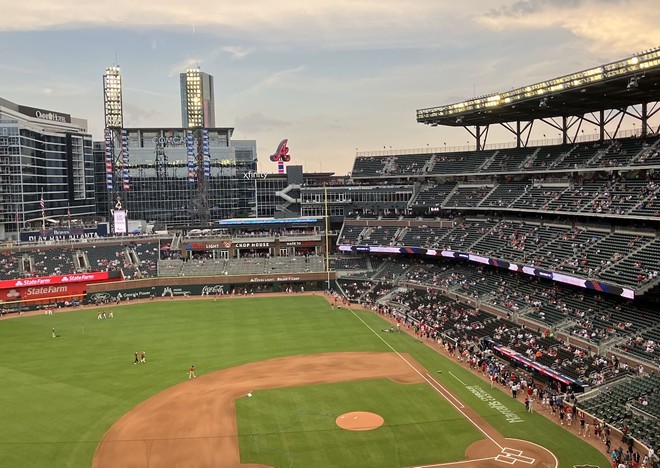
We raise our beer for the vet who lost his fingers and face in the second Gulf war. The screen shows a photo of his charred Hummer. The crowd stands, applauding the sacrifice from this war for oil (in every way except using less gas). A small sign translates baseball terms into the Cherokee language and syllabary. When Braves catcherTravis d’Arnaud launches a grand slam, the lights dim and the crowd launches into the team’s patently offensive Tomahawk Chop.
This is manufactured group-think. An Orwellian nightmare, softened by craft beer.
At Truist Park, a logo-script Atlanta "A" towers over right field. The "A" also serves as a supplementary, sculptured screen. Through most of the game, the "A" projects the Braves' signature hatchet twine, handle, and stone head. During the national anthem, the "A" waves like an American flag. After the d'Arnaud grand slam (the game winner, it turns out), the "A" blinks out a siren. At one point, no one else saw, but I swear the "A" projected hypnotic spirals, sending a subliminal message to buy a $10 hotdog and another round of beer.
OK. I exaggerate. The strategies are more subtle. The LED lights and blinking screens dish out steady microdoses of dopamine. When the action lulls, the system bumps up the volume with pop songs, organ riffs, and energetic announcements, keeping the noise at a steady 90 decibels. Mild, sonic discomfort is followed by adrenal pleasure. All your needs met by CocaCola-Delta-HomeDepot-Truist-(formerlySunTrust)-ChikFilA Park.
We have placed all trust for the public good with the corporate sector. I know I’m railing like a prophet from the Torah, but really, how else to explain the negotiation off the rails? How else to describe this bait-and-switch, where civic needs are met with empty commodified pleasures—except by brainwashing? Truist Park is cash-free. I have downloaded the MLB app (which also tracks my location) and in just four hours, my tab has topped $200.We have placed all trust for the public good with the corporate sector.
tweet this
Let’s state the obvious. With its $1.3 billion dollar stadium, St. Petersburg and Pinellas County will make the same mistake twice. Forty years ago, civic leaders and a fawning press pushed through the plan to raze an African-American neighborhood and build a domed stadium. Forty years later, elected officials (and the same fawning press) will leverage public debt to support the same bullshit claims. There will be gains. The Carter Woodson deserves a bigger, better home. The Gas Plant's history will be told.
But as for real change?
Expect market-tested community, with just enough ghost history to get the deal done. Expect AstroTurf, not grass roots. Mirrored buildings, reflecting back the face of consumption. Expect stories of reconciliation with the past, slapped over continuing inequity.
Expect little for affordable housing. Under the current deal the Rays can buy out designated units for $25K each; for the equivalent of six to eight months rent, basically, a blueprint for justice will be diverted to private gain.
And traffic, expect traffic.
The ugliest feature of Tropicana Field has always been the sea of empty blue seats. Without transit, future fans will continue to watch from home, admiring the shining surface—and servicing the debt—of a very expensive crypt.
After almost a decade of deliberations, St. Petersburg now rushes headlong into a reckless deal. City Council held a workshop this month and received so much pushback that a follow up discussion—and the vote—on the deal is delayed until at least June, according to Axios.
The plan, as-is, squanders a once-in-a-generation opportunity to fix the problems of a still-living past. Instead we’ll get nods to local history, an entertainment district with a suburban sheen, and high-ending housing, serving the already rich.
On WMNF last Friday, St. Petersburg City Councilman Richie Floyd said characterizing the Rays-Hines proposal on affordable housing as "lacking something" is generous.
“The way the deal is written right now is that it provides a framework for how many units could happen in the future. But it says very clearly in the fine print, that the city will have to provide subsidies to actually create this affordable housing,” Floyd added. “So they're basically saying, ‘Yeah, we'll work with you on affordable housing deals, but you're gonna have to give us more money to do it.’”
The local chapter of the Sierra Club has expressed concerns about the environmental impact—concerns that weren’t even addressed last week. For now, Floyd is waiting for news of the real cost of the stadium to sink in with constituents.
“We're going to give $500 million, over 30 years to a baseball stadium,” Floyd said, adding that “the assistant city administrator admitted that the cost of the subsidy per person in the city is $2,600.”
“I think as that information starts to come out, as we talk about what the true cost of the stadium is, we'll get a much clearer picture,” Floyd said about whether or not council will vote for or against funding the stadium. “I'm just hoping that my colleagues actually look with a critical eye, and don't just trust the promises of the billionaire class. Because I think working people know, inherently, that shit doesn't fly.”
Say “no” to this unreal city. Take note of this road trip. Tell St. Petersburg City Council, tap the brakes.
Thomas Hallock teaches English at the St. Petersburg campus of the University of South Florida. He has now been writing columns for Creative Loafing Tampa Bay about the Trop site, on and off, for seven years.
Subscribe to Creative Loafing newsletters.
Follow us: Google News | NewsBreak | Reddit | Instagram | Facebook | Twitter

